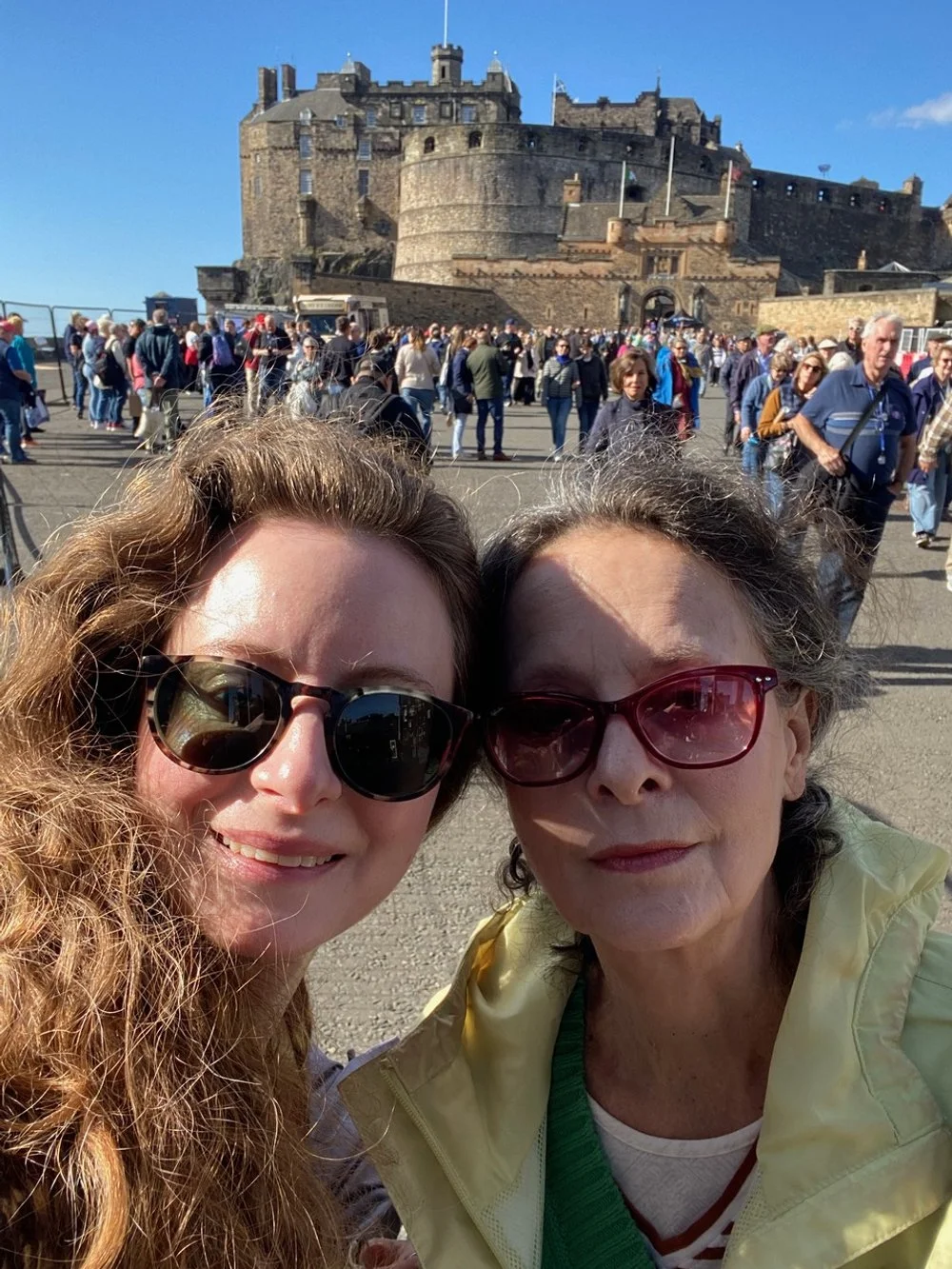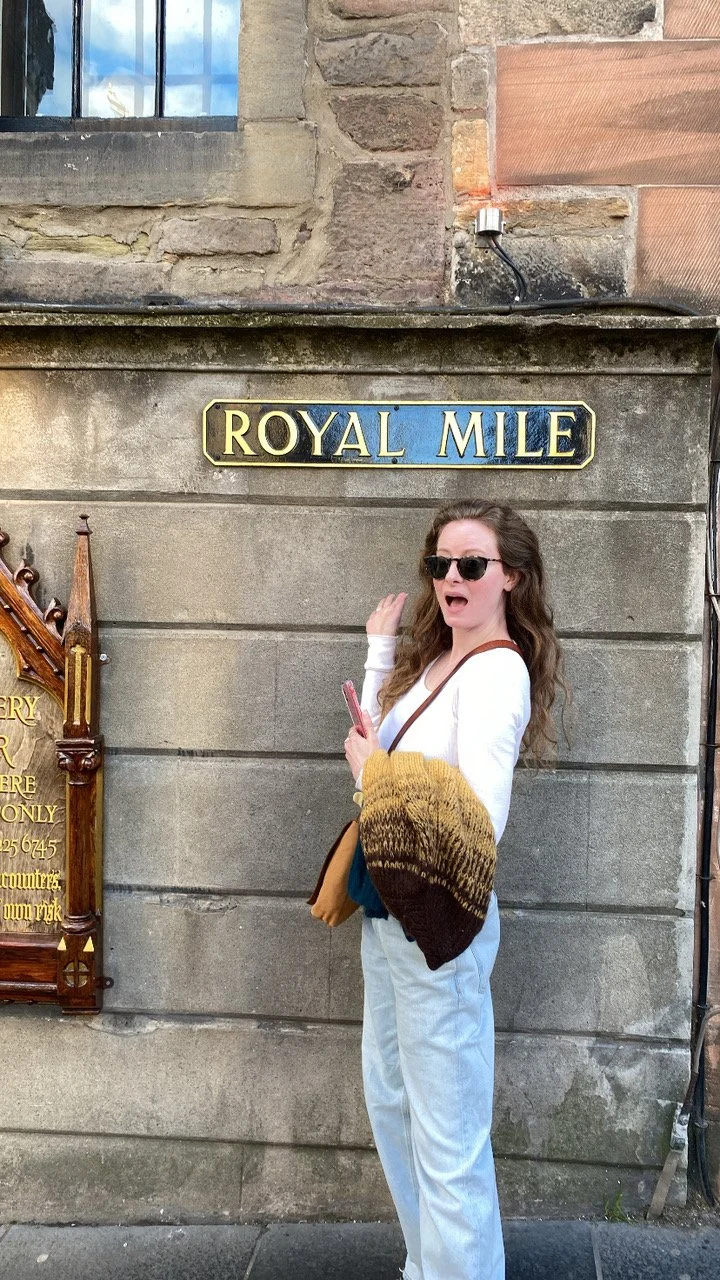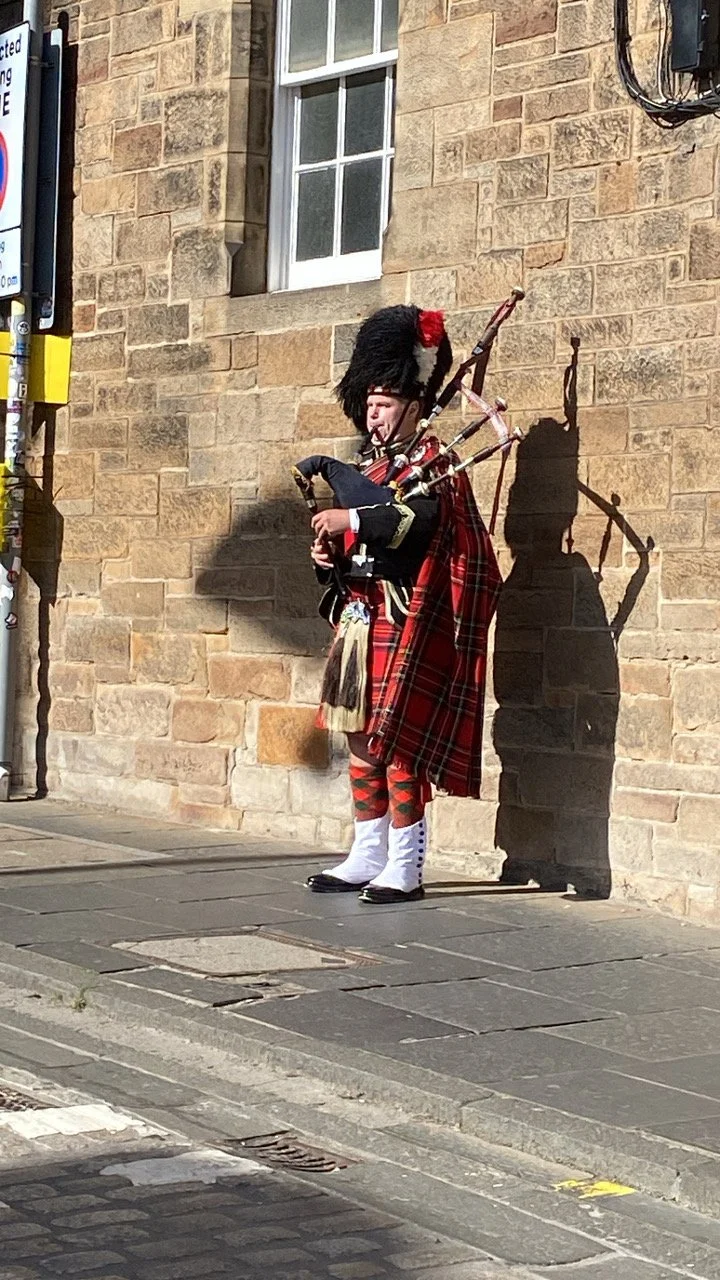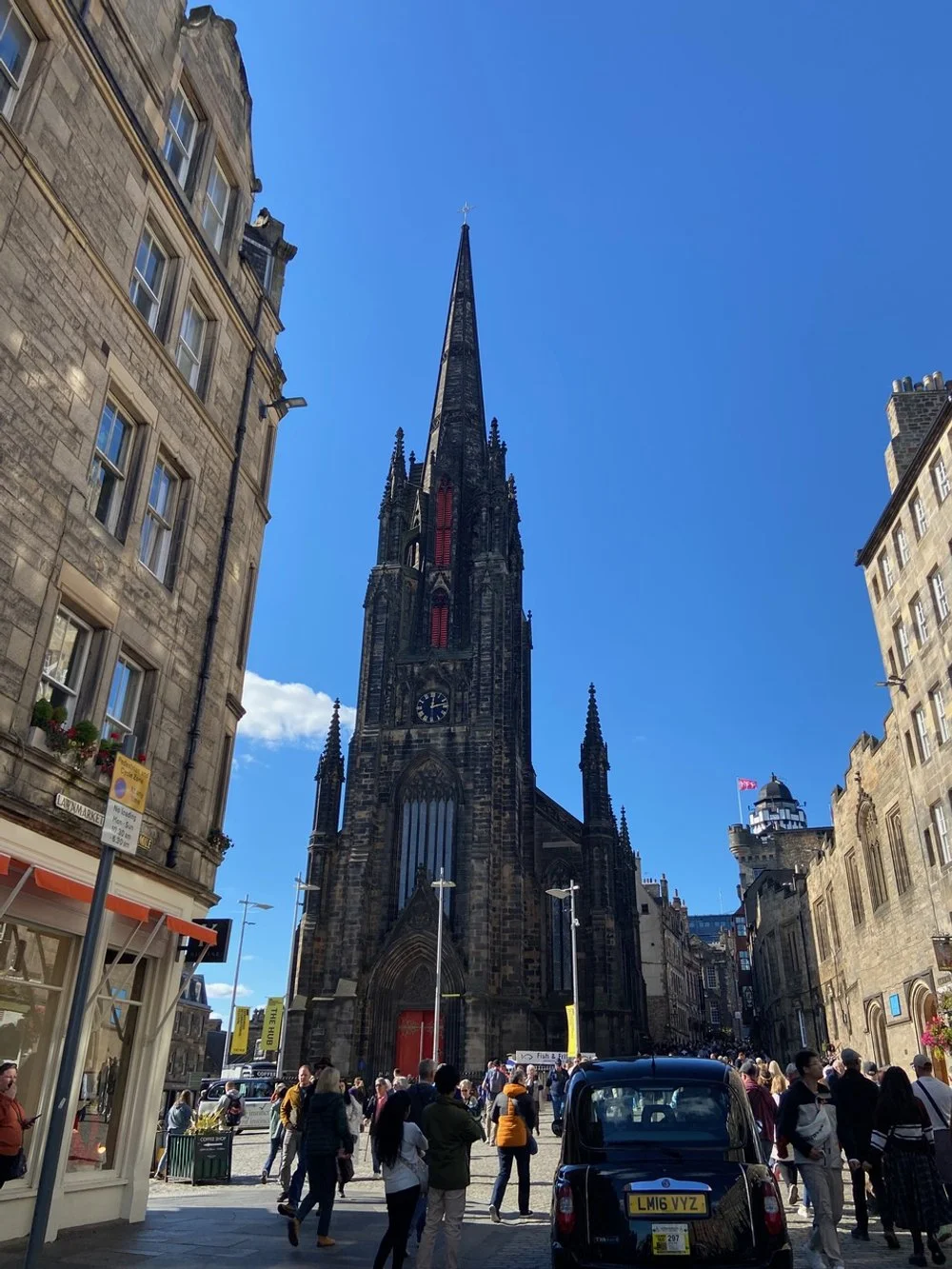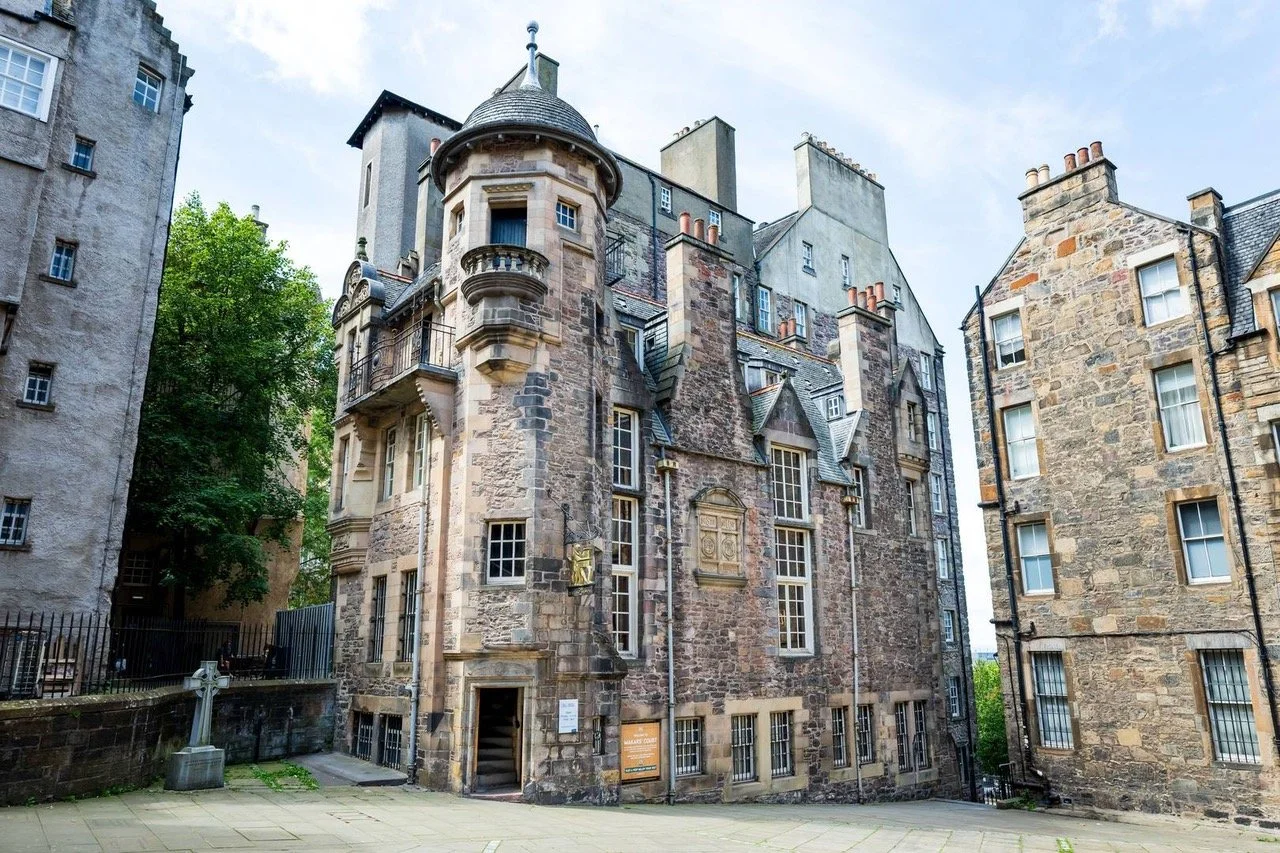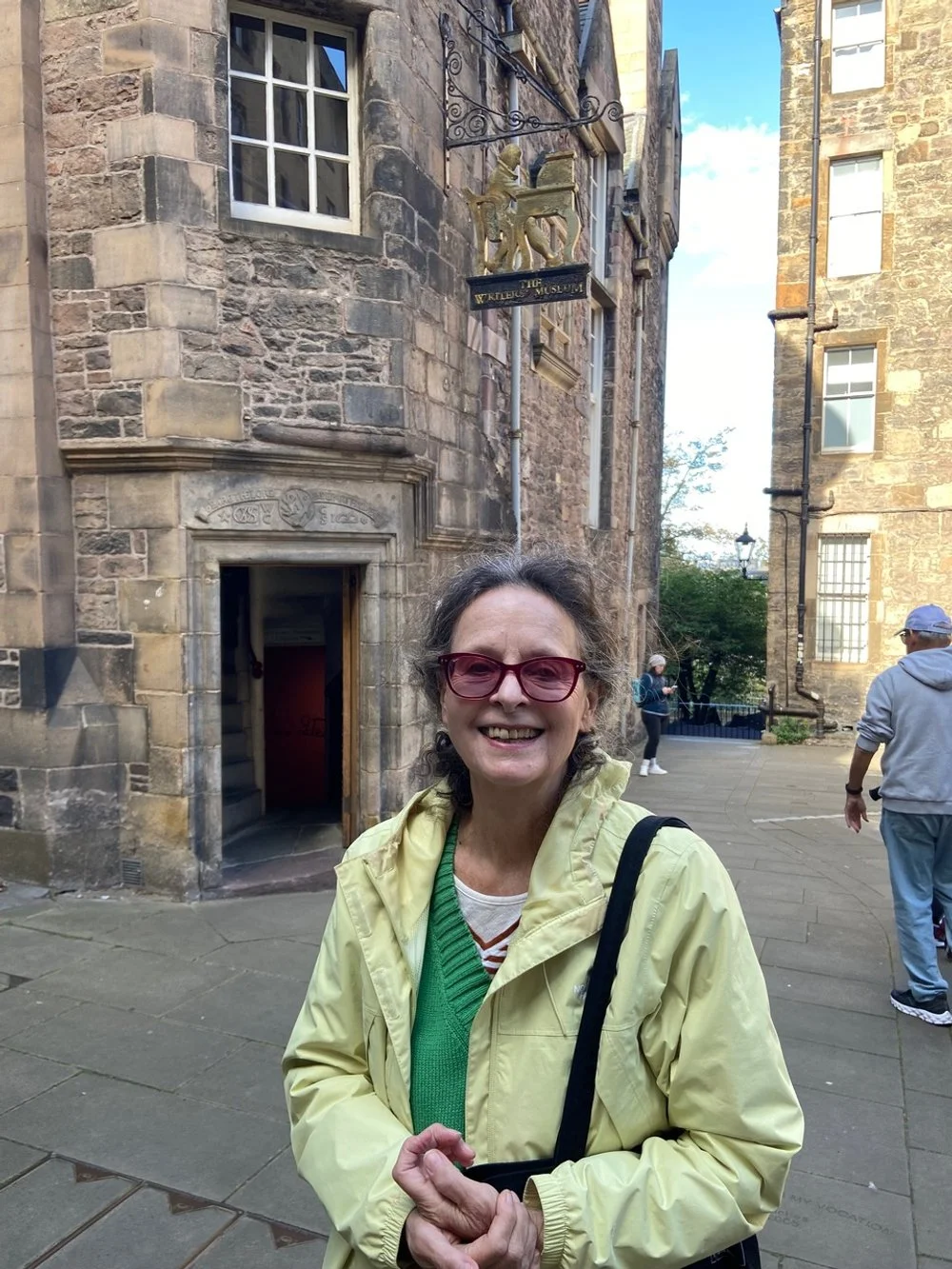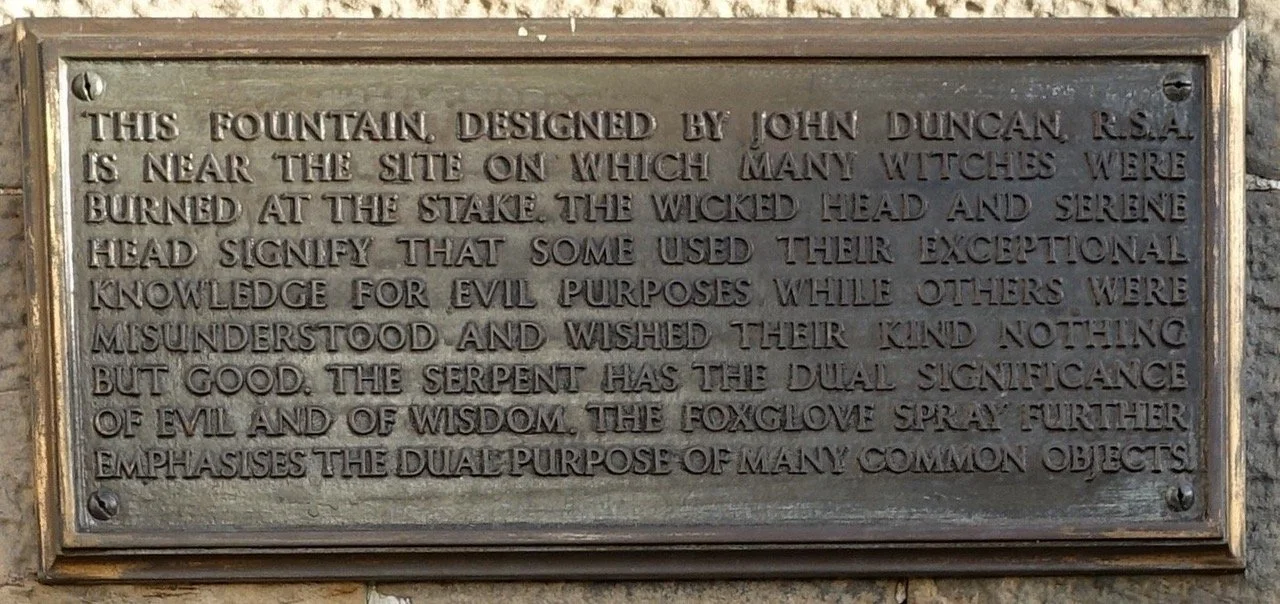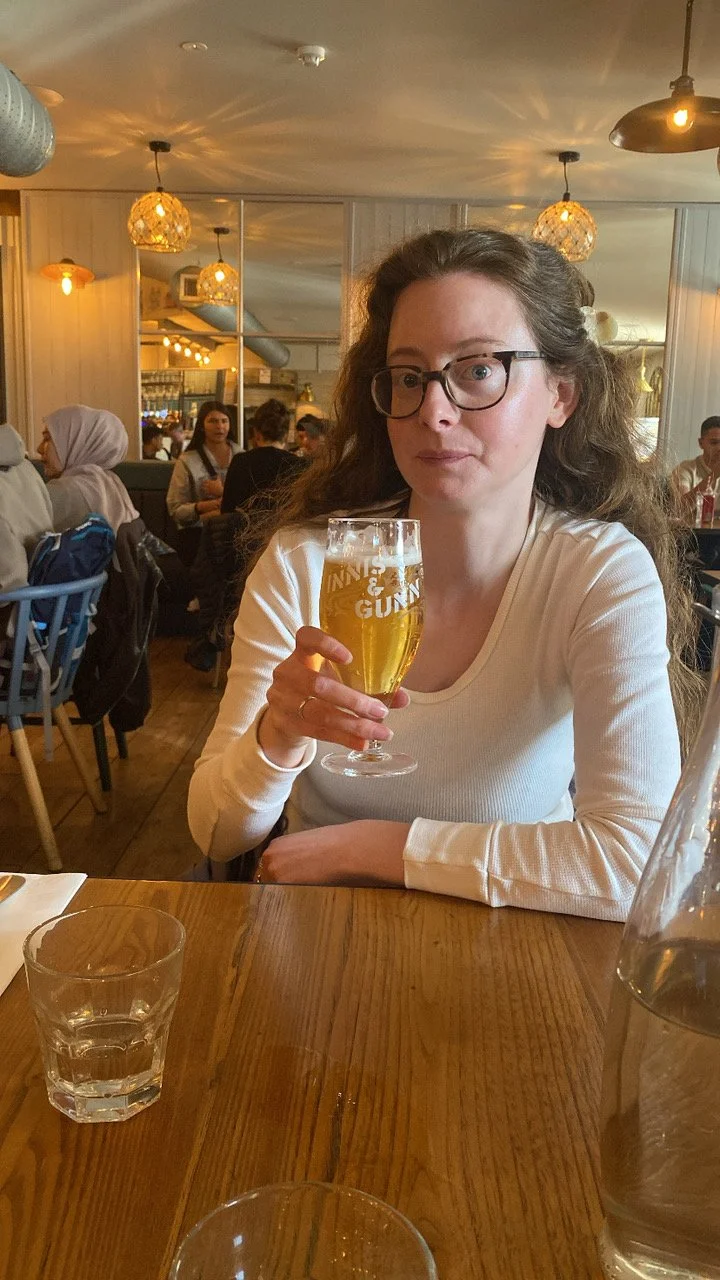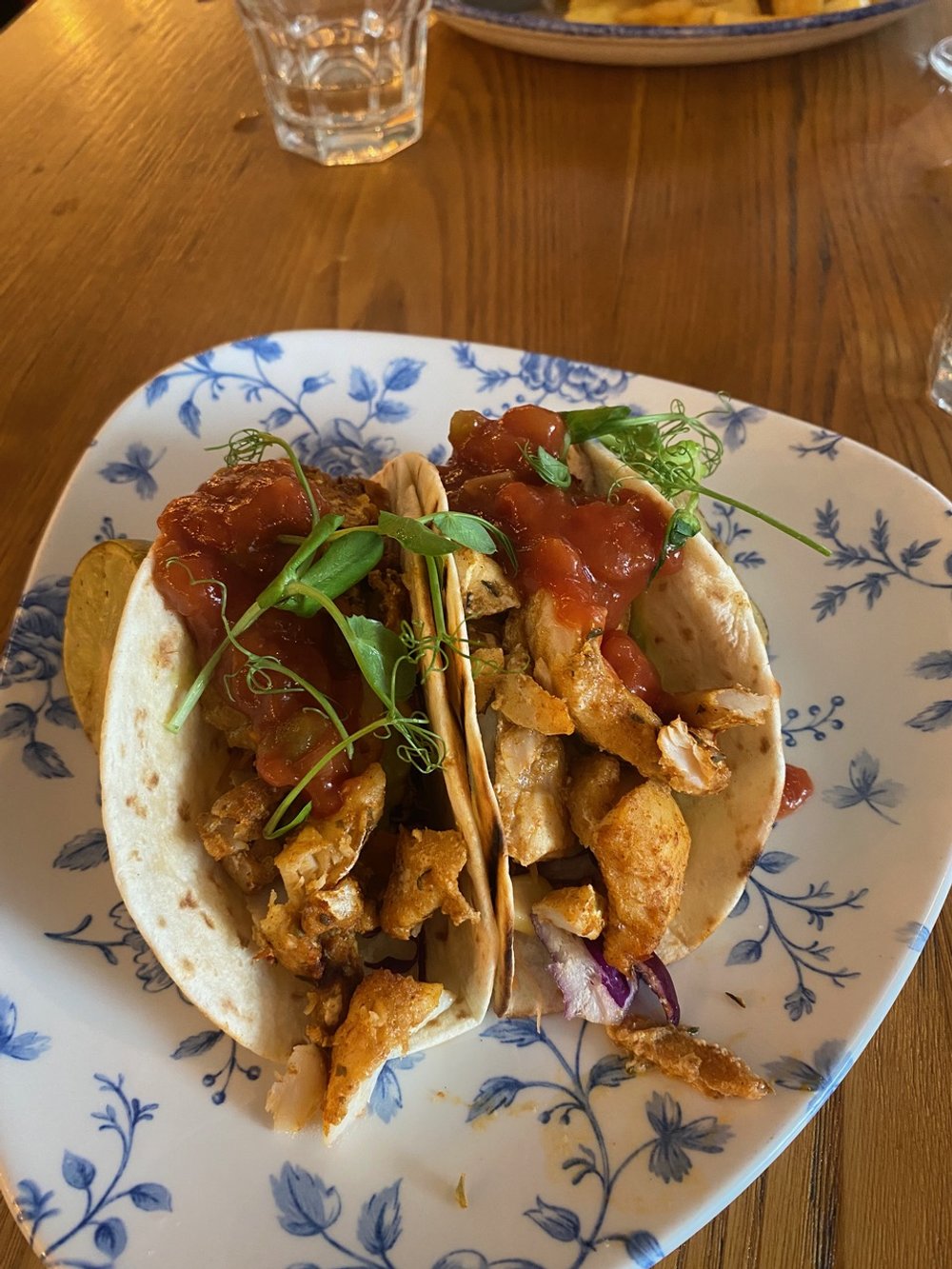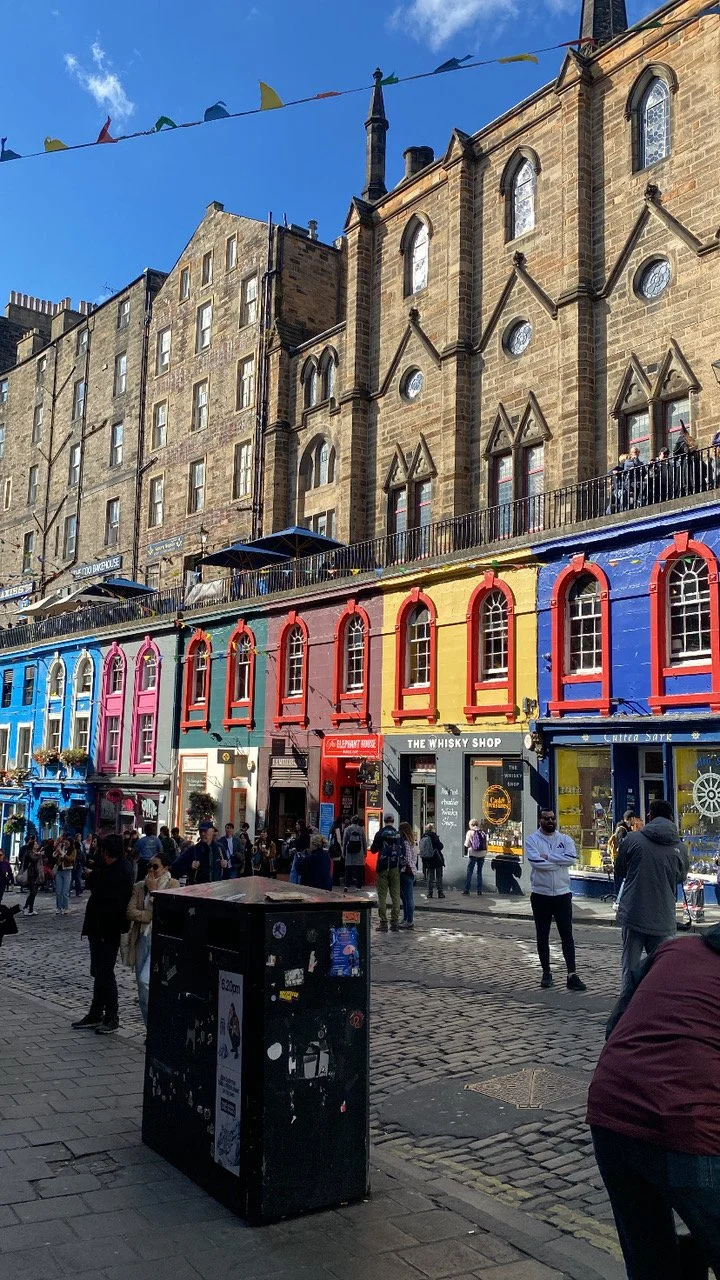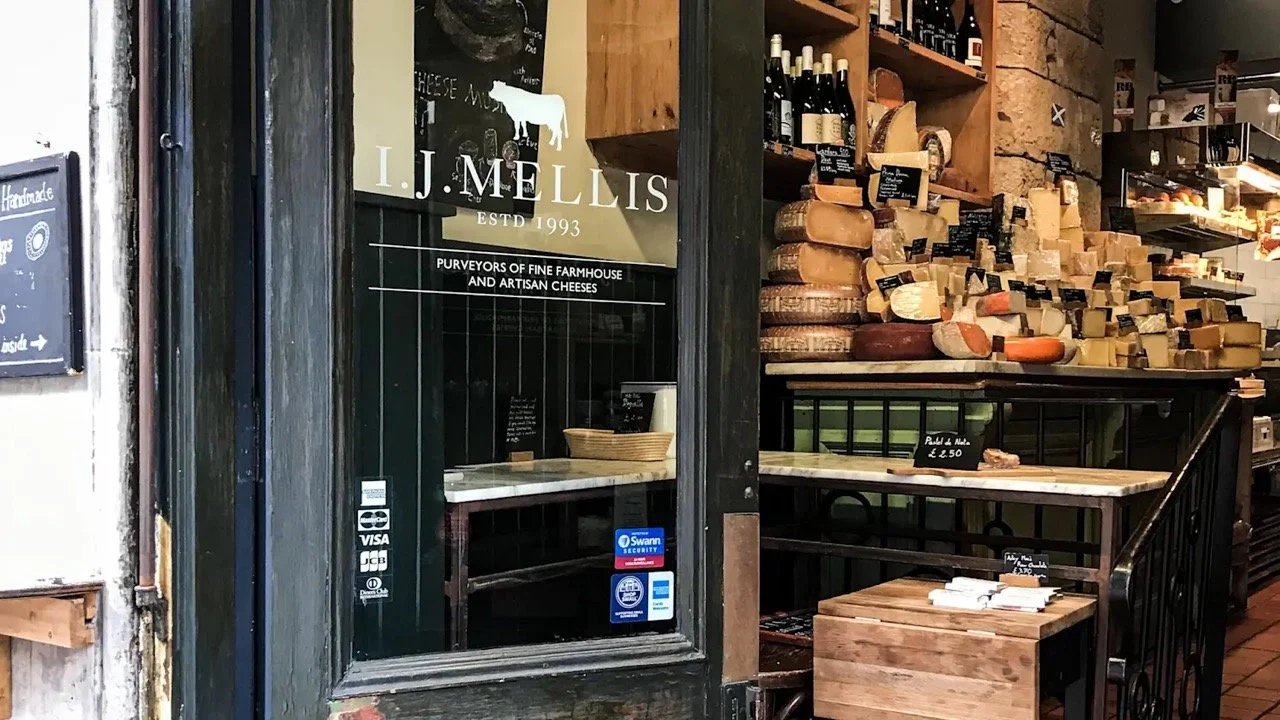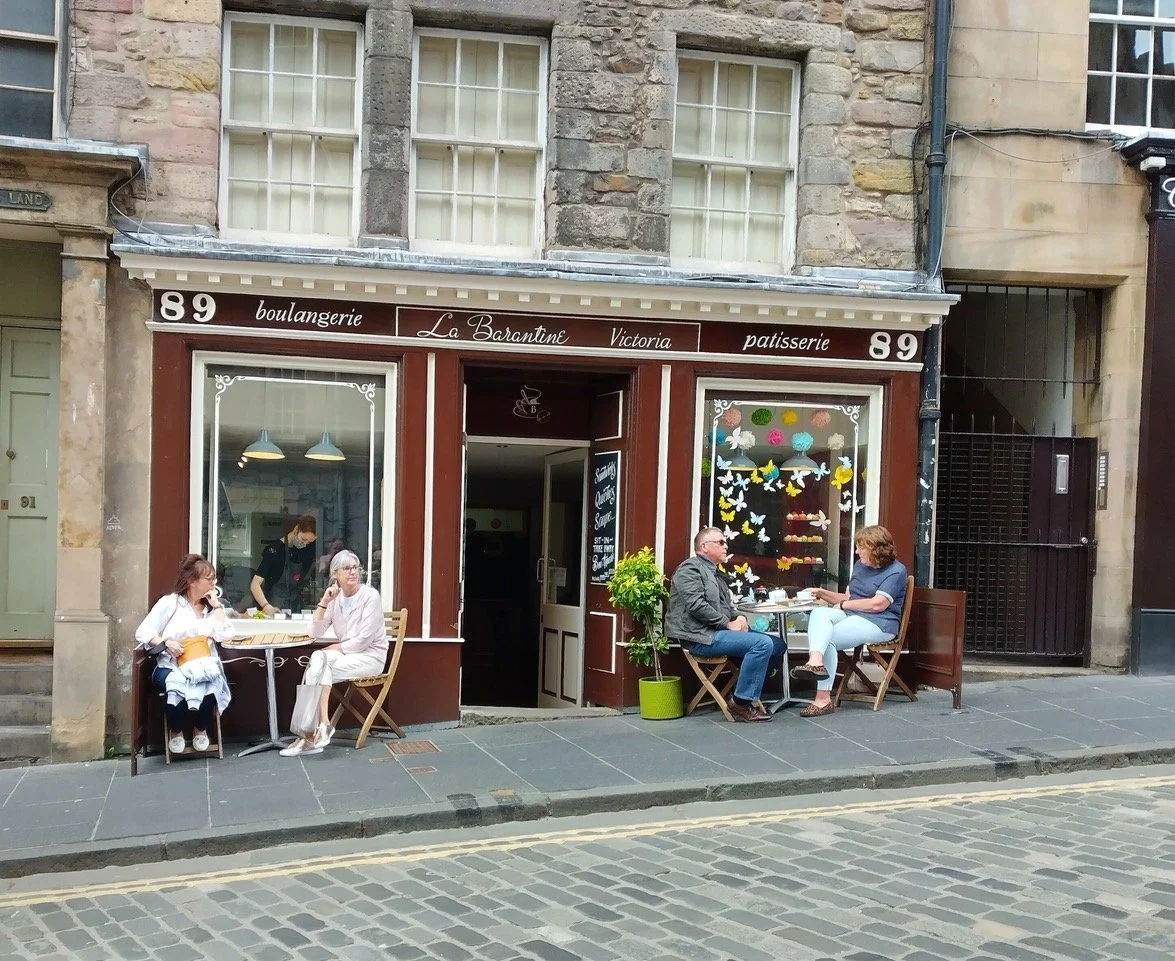On top of Auld Reekie
….a few days in Edinburgh
Edinburgh Royal Mile with Edinburgh Castle behind us
Bienvenue and welcome back to Musée Musings, your idiosyncratic guide to Paris and art. This week we’re in Edinburgh. We liked Glasgow but we loved Edinburgh. It might be because in Edinburgh we stayed in an apartment rather than a hotel. And after almost three weeks in a different hotel each night, it was nice to have more than a bedroom to share with my dear daughter. The apartment we found was through a new home swapping company called Kindred. The basic idea is the same as HomeExchange through which I’ve been welcoming guests to my place in the south of France for years and through which I have stayed at Stephanie’s house in Normandie, in Dives-sur-Mer. But Kindred seemed more appropriate for city exchanges and so I put my San Francisco house onto their ’platform’ and started my Kindred adventure in Edinburgh. The place that was available wasn’t my first choice, because it was in the seaside town of Portobello, a 20 minute bus ride from Edinburgh. And because it was much too big for us. Configured like the spikes of a bicycle wheel, 5 bedrooms, two bathrooms, one kitchen and one living room radiated around a central space which was set up as a dining room. We kept getting lost, especially at night when we tried to find a bathroom!
For the three full days we were in Edinburgh, we fell into an easy pattern. Because Edinburgh was so far from the flat, we were obliged to have lunch out and for a number of reasons - amongst them the weather, restaurant meals rather than sandwiches in the park made more sense. And because we had a flat, we could comfortably eat dinner at home. Restaurant dinners in Glasgow had been mostly disappointing The first night we ate at a Chinese restaurant where we ordered dishes with which we were familiar. The taste of all the dishes was so off that I insisted Ginevra stop eating. We hadn’t begun our walk yet and the last thing we needed was food poisoning. Another time we ate at a seafood place recommended by Sam Hueghn. The portions were small, the prices were big and the seats were uncomfortable (backless stools at the bar). Our lunches in Glasgow, which we ate in the park, were a little off, too. Both were from a sandwich shop Ginevra noticed as we looked for a SIM card for her cell phone. The first sandwich we had was a riff on the Vietnamese ‘Banh Mi,’ with ingredients that must be particular to Scotland, or maybe just Glasgow. The other sandwich, called a Nottolenghi, was definitely not based on a recipe by Yotam Ottolenghi whose restaurants in London are my favorites. By the time our last night in Glasgow rolled around, we threw in the towel and ordered a pizza to eat in our hotel room. It was delicious. As were the breakfasts at our Glasgow hotel - strong coffee, nice tea selection, real scones, fresh fruit and an assortment of cheeses.
The train ride from Glasgow to Edinburgh was fast and easy. We worried about finding the right bus stop and then the right bus for Portobello and wondered if we would be able to get our luggage onto the bus. But all that was resolved when the young woman I was sitting next to on the train suggested that we take an Uber. Which I haven’t done in Paris for years. In Paris, Ubers are mostly not reliable and since I mostly take taxis to and from the airport, I don’t really need Ubers because those taxi fares are set. But Ubers do work in Edinburgh and that’s how we got to the apartment that first day.
By the time we sorted ourselves out in the apartment - what with a key that didn’t work and two flights of stairs that made all the stairs we had experienced the previous two weeks seem like child’s play - the butcher shop and greengrocer and bakery on Portobello’s High Street were closed. Sainsbury was still open so we bought breakfast essentials and decided that since we weren’t in Portobello for Portobello, we weren’t going to hang around the next morning, or any other morning, to shop for dinner before we left for the day. We could have eaten in one of the several bars and bistros along the beach but the beauty of having a place with a kitchen is eating at home. So, our itinerary was set, restaurant lunches in Edinburgh and before we left Edinburgh, we would buy ingredients for dinners at home.
Getting into Edinburgh from Portobello on the bus proved to be easy if not fast. No correct change was required, no bus card either. Like the London tube, you just swipe your credit card and find a seat. For our first day in Edinburgh we tackled the Royal Mile with Rick Steves. That is to say, we walked along listening to his audio walking tour on my cell phone. At the top, where the tour starts, is the Edinburgh Castle and at the bottom is the Palace of Holyrood. Edinburgh Castle stands on Castle Rock, a volcanic formation which is estimated to have been formed 350 million years ago. Humans arrived considerably later and there has been a royal castle on the rock since the 11th century. The castle stopped being a royal residence in the mid 17th century. The Palace of Holyrood, where the current Royals hang out when they are in Edinburgh, has also been around a long time. We didn’t visit either, we just milled around the courtyards with lots of other folks.
Edinburgh Royal Mile Street Sign, Edinburgh
Between these two royal residences is the Royal Mile, the main thoroughfare of Edinburgh’s Old Town. This combination of medieval streets and 16th and 17th centuries buildings, is a UNESCO World Heritage Site. Closes (the Scottish term for alleyways) and courtyards branch off the main spine. They are narrow, tiny and steep. The names of the closes and courtyards are either from a particular occupant who achieved fame or notoriety or a particular occupation practiced by one or more of its inhabitants. We wandered down the ones Rick told us we could and enjoyed the views. Along the main ‘drag’ of the Mile are churches, government buildings, museums and memorials.
We wandered into a few churches but we skipped the Tenement Museum because we had been to the one in Glasgow. We did visit the Writers’ Museum, a free museum that celebrates the lives of three prominent Scottish writers – Robert Burns, Sir Walter Scott and Robert Louis Stevenson. The Museum is located in a 17th century townhouse that has been a museum for over a century. It contains an eclectic mix of stuff. Some of which you might expect, like portraits of all three and the first editions of Scott’s novel Waverley and Stevenson’s, A Child’s Garden of Verses and a draft of Burns’ ‘Scots Wha Hae’. And there’s the press on which Scott’s Waverley novels were printed and the chair Burns sat on when he corrected proofs at William Smellie’s printing office. But there’s also Scott’s rocking horse and Stevenson’s riding boots. And some of Stevenson’s clothes, crafted by the Deacon Brodie, whose double life may have inspired ‘The Strange Case of Dr Jekyll and Mr Hyde’.
Rick told us about William Brodie as we approached the Deacon Brodie Tavern on the Royal Mile. Turns out, William Brodie (1741-1788) was a cabinet-maker, deacon of a trades guild and a city councillor. By day, he was a respectable businessman. By night he was a burglar who stole to support his two mistresses, the five children he had between them and his gambling addiction. He was in a perfect position to steal from the people who were his victims, he had made the keys for their locks and had kept wax impressions of them. His final burglary, flight and capture makes for good reading. He was put on trial, found guilty and hanged before a crowd estimated at 40,000. He was only 47. (Figs 1-8)
Figure 1. Bagpiper playing on Royal Mile, Edinburgh
Figure 2. Royal Mile, Edinburgh, with the sky so very very blue!
Figure 3. Writers Museum, Royal Mile, Edinburgh
Figure 4. Me in front of the Writers Museum, Royal Mile, Edinburgh
Figure 5. Writers Museum Interior, Royal Mile, Edinburgh
Figure 6. Writers Museum printing press
Figure 7. Disrupting the Narrative. As the difficult job of confronting racism is destroyed in the U.S., museums in Scotland (like museums I visited in Berlin) have signs like this. Writers Museum
Figure 8. Deacon Brodie Tavern, Royal Mile, Edinburgh
That’s one death we learned about on this walk. But there were many more and those are commemorated by the Witches' Well. A monument to the thousands of people, mostly women, who were burned at the stake in Edinburgh for being witches. The monument is a drinking fountain, although it no longer works. Why a fountain? Surely because water was the way an accused person was confirmed to be a witch. The accused would be tied up and thrown in a river or loch (lake). If they sank, it was a sign that they were not a witch and they would hauled out of the water (hopefully before they drowned). The belief was that water was pure and would reject evil, so if the person thrown into the water floated, they were a witch because the water ‘rejected’ them. The ‘floater’ was then strangled and burnt at the stake. The Witches’ Well is located very close to where the witches were actually burnt. According to one source, "In Scotland from the 16th to 18th centuries, between 3000 and 4000 people were tortured, convicted and executed as witches. …(M)ore people (were) strangled and burnt at the stake on Edinburgh Castle's esplanade than anywhere else in Scotland.”
The bronze relief above the monument’s water spout is richly ornamented. There’s a foxglove plant, a snake curled around the heads of the Greek goddess of good health and her father Aesculapius, god of medicine. There are trees, healing hands, and the evil eye. In the top left and bottom right corners are the Roman numerals for the years 1479 and 1722, the nearly three centuries during which most witches were persecuted in Scotland.
The inscription on the plaque above the fountain, written in 1912, reads: “This fountain… is near the site on which many witches were burned at the stake. The wicked head and serene head signify that some used their exceptional knowledge for evil purposes while others were misunderstood and wished their kind nothing but good. The serpent has the dual significance of evil and wisdom. The foxglove spray further emphasizes the dual purpose of many common objects.” The inscription doesn’t question that some of the people burned at the stake were witches. And doesn’t apologize for the false accusations and the confessions under torture of the many women (and men) who were innocent victims of witch hunts.
It reminded me of a post I wrote 6 years ago, on the artist Kiki Smith and her exhibition at the Musée de la Monnai. One of her works, entitled, ‘Pyre Woman Kneeling’ is a nude woman, in bronze, with outstretched arms, kneeling on a stack of wooden planks. The sculpture began as an entry in a competition for an outdoor sculpture. At the time, Smith was making “drawings of drowned witches, of them floating with their hair in the water.” Smith decided not to enter the competition. She didn’t want to make public sculpture for other people’s agendas. But then she decided that sculptures of women on pyres should be commemorations for witches, which she thought should be set up in towns all over Europe. As Smith so rightly noted, “(t)here was a tremendous amount of killing, and there’s little commemoration of that..… No town has commissioned one so far,“(b)ut you know, I just make them anyway. Their arms are out, like Christ saying, ‘Why have you forsaken me?” (Figs 9-13)
Figure 9. Witches Well, Royal Mile, Edinburgh
Figure 10. Witches Well plaque, Royal Mile, Edinburgh
Figure 11. Contemporary explanation of the site, Witches Well, Royal Mile, Edinburgh
Figure 12. Woman on pyre, Kiki Smith, 2000
Figure 13. Woman on pyre, Kiki Smith, another version
Thinking about Smith’s sculpture and seeing this monument reminded me all over again of the ways strong women are undermined by the patriarchy. The best remedy for ‘uppity’ women, historically and currently, is to take away their power and their property. And the easiest way to do that is to accuse them of being unfit, accuse them of being a witch. According to the United Nations, women being killed for witchcraft is growing and nowhere faster than in India where older women are accused of being witches as a pretext for seizing their lands and their goods. When Hilary Clinton was running for president, images of her in a witch’s hat and robes abounded. And not only at Halloween. Lately, things have gotten worse. In the United States, echoes of Margaret Atwood’s The Handmaid’s Tale are everywhere as women lose their agency and individuality, as their productive rights are being suppressed. As they are being urged to stay at home and have children, just like The Stepford Wives.
After all those heavy thoughts, I needed lunch. While Ginevra respectfully wandered around the interior of one of the churches we visited, I googled places to eat. I chose Bertie’s Proper Fish and Chips. It was the perfect choice. The restaurant was lively and comfortable and welcoming. Ginevra ordered fish and chips. Which was mostly fish, very fresh fish and only lightly breaded. I took a risk and ordered fish tacos - fantastic. They reminded me of the fish tacos I ate a long time ago at the Ferry Building. Those were fantastic, too. But those tacos were tiny, these tacos were the perfect size. (Figs 14-16)
Figure 14. Bertie’s Proper Fish and Chips, Victoria Street, Edinburgh
Figure 15. Fish and Chips at Bertie’s, the way all fish & chips should be made!
Figure 16. The perfect fish tacos at Bertie’s Proper Fish and Chips, Victoria Street, Edinburgh
Bertie’s was not only an excellent restaurant, it was on a most charming street, a steep street of cobblestones, called Victoria Street. According to one source, “with its colorful facades and unique shops, this street showcases Edinburgh’s architectural diversity and historical legacy.” It was designed by the architect Thomas Hamilton, who was a strong proponent of neoclassicism, who was obsessed with the architecture of ancient Greece. But he followed his mandate here and designed the facades of these buildings in the ‘Old Flemish’ style. With its unusual shape and collection of quirky shops, its said to be the idea behind Harry Potter’s Diagon Alley.The pastel colored facades reminded me of similar streets in Paris, San Francisco and Copenhagen. (Figs 17-20)
Figure 17. Victoria Street, Edinburgh
Figure 18. Quai de Valmy, Paris
Figure 19. Nyhavn, Copenhagen
Figure 20. Harry Potter Museum & Merch, Victoria Street, Edinburgh
As we were wandering along this street, I noticed a sign for I.J. Mellis, a cheese shop which Sam Hueghn had lauded in his NYTimes article on Glasgow. We didn’t get there in Glasgow. I’m sure glad we got there in Edinburgh. I have my favorite cheese shop in San Francisco (Cow Girl Creamery) Bordeaux, (Jean d’Alos) and London (Neal’s Yard). Now I have a favorite cheese shop in Scotland. I was interested in the history of this cheese shop and this is what I learned from their website. Iain Mellis, the founder of the cheese shop has a particular passion - farmhouse cheeses. And that’s because the milk comes from a single herd rather than many herds,. By specializing in farmhouse cheeses (many of which are matured in their own cellars) this cheese shop can offer its customers both lesser known varieties to choose from and cheeses of more complex flavors. We bought something that I usually avoid, a pre-cut assortment of five cheeses, to which we added two others that appealed to us and a little bit of quince paste.
The very helpful woman at the cheese shop pointed us to a French boulangerie across the way, La Barantine, where we bought an expensive (by French not San Francisco standards) baguette. Which was delicious, as was the croissant we bought for our breakfast the next morning. Not surprisingly, the boulanger is French. (Figs 21-24)
Figure 21. I.J. Mellis, Cheesemonger, Victoria Street, Edinburgh
Figure 22. A bit of the selection of cheeses eat I. J. Mellis, Victoria Street, Edinburgh
Figure 23. I don’t have a photo of the cheeses but I do have this list of what the cheeses were, I.J. Mellis
Figure 24. La Baratine, Boulangerie & Patisserie, Victoria Street, Edinburgh
We came home early that first day and walked along the beautiful beach of Portobello. (Figs 25, 26) We weren’t tempted to eat at any of the bars or bistros on the beach because we had our cheese platter and French baguette and bottle of wine waiting for us at home. To be continued. Gros Bisous Dr. B.
Figure 25. Ginevra on the Portobello boardwalk
Figure 26. Me on the Portobello boardwalk
Figure 27. Porobello Boardwalk is a lively place
Thanks so much to those of you who sent in a Comment. As always, they are much appreciated.
New comment on After the Highlands, the Lowlands beckoned:
Beverly, your last article is great as always! What a pleasure to read your text about your trip and the art it inspired you. It's wonderful to see how your deep passion for art is reflected in your writings and in the way you travel the world. It is clear that this passion offers you an incredibly rich life full of discoveries. Keep making us travel through your unique look! Gérard - Paris
Thank you for another great read Beverly. The Huntarian has done a great job on MacIntosh and I enjoyed his house too, but even better if you ever had more time was the ‘House of an Art Lover’ set in a park and on a much grander scale. It was the reproduction of a competition design he and his wife had put together and is magnificent with gorgeous detailing by Margaret, Their use of light and dark was extraordinary. They failed to qualify for the competition for some reason and were disqualified, but a father and daughter architect decided it was worth building and so it was. My favourite bit of Glasgow, but a bit far from the centre where you were staying. Katherine, Oxford, England
